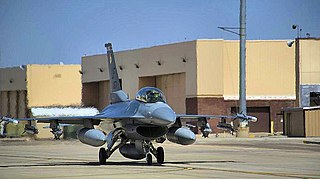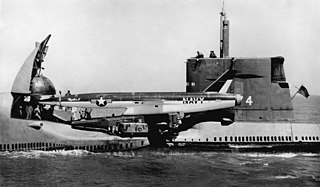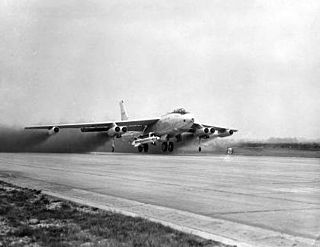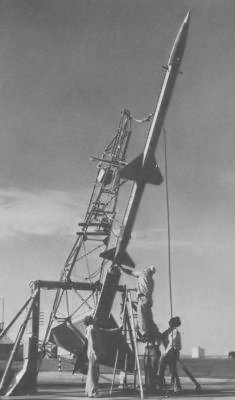Related Research Articles

A rocket sled is a test platform that slides along a track, propelled by rockets.

Ham, a chimpanzee also known as Ham the Chimp and Ham the Astrochimp, was the first great ape launched into space. On January 31, 1961, Ham flew a suborbital flight on the Mercury-Redstone 2 mission, part of the U.S. space program's Project Mercury.

The Convair F-106 Delta Dart is an all-weather interceptor aircraft designed and produced by the American aircraft manufacturer Convair.

White Sands Missile Range (WSMR) is a United States Army military testing area and firing range located in the US state of New Mexico. The range was originally established in 1941 as the Alamogordo Bombing and Gunnery Range, where the Trinity test site lay at the northern end of the Range, in Socorro County near the towns of Carrizozo and San Antonio. It then became the White Sands Proving Ground on 9 July 1945.

In aircraft, an ejection seat or ejector seat is a system designed to rescue the pilot or other crew of an aircraft in an emergency. In most designs, the seat is propelled out of the aircraft by an explosive charge or rocket motor, carrying the pilot with it. The concept of an ejectable escape crew capsule has also been tried. Once clear of the aircraft, the ejection seat deploys a parachute. Ejection seats are common on certain types of military aircraft.

Before humans went into space in the 1960s, several other animals were launched into space, including numerous other primates, so that scientists could investigate the biological effects of spaceflight. The United States launched flights containing primate passengers primarily between 1948 and 1961 with one flight in 1969 and one in 1985. France launched two monkey-carrying flights in 1967. The Soviet Union and Russia launched monkeys between 1983 and 1996. Most primates were anesthetized before lift-off.

The Aerojet General X-8 was an unguided, spin-stabilized sounding rocket designed to launch a 150 lb (68 kg) payload to 200,000 feet (61.0 km). The X-8 was a version of the prolific Aerobee rocket family.

Holloman Air Force Base is a United States Air Force base established in 1942 located six miles (10 km) southwest of the central business district of Alamogordo, which is the county seat of Otero County, New Mexico, United States. The base was named in honor of Col. George V. Holloman, a pioneer in guided missile research. It is the home of the 49th Wing of the Air Education and Training Command (AETC).

The Fairchild SM-73 was a planned sub-sonic, jet-powered, long-range, ground-launched decoy cruise missile. XSM-73 was the designation for the development version. Development began in 1952 with conceptual studies and ended when the program was canceled in 1958 after 15 test flights but before any operational deployment. The operational concept was to base squadrons of XM-73s at various locations in the United States and if necessary launch the aircraft as part of a strategic bomber attack. The aircraft would fly autonomously under inertial guidance towards the target area, using radar reflectors and electronic countermeasures to imitate American bombers and thus confuse and saturate enemy air defenses. The program was cancelled because the missile was not able to simulate a B-52 bomber on radar.

The Air Force Missile Development Center and its predecessors were Cold War units that conducted and supported numerous missile tests using facilities at Holloman Air Force Base, where the center was the host unit.

Enos was a chimpanzee launched into space by NASA, following his predecessor Ham. He was the only chimpanzee to orbit the Earth, and the third hominid to do so after cosmonauts Yuri Gagarin and Gherman Titov. Enos's flight occurred on November 29, 1961.

The SSM-N-9 Regulus II cruise missile is a supersonic guided missile armed with a nuclear warhead, intended for launching from surface ships and submarines of the U.S. Navy (USN).

The High Virgo, also known as Weapons System 199C (WS-199C), was a prototype air-launched ballistic missile (ALBM) jointly developed by Lockheed and the Convair division of General Dynamics during the late 1950s. The missile proved moderately successful and aided in the development of the later GAM-87 Skybolt ALBM. It was also used in early tests of anti-satellite weapons.

Weapons System 199 (WS-199) was a weapons development program conducted by the United States Air Force to research and develop new strategic weapons systems for Strategic Air Command. Two air-launched and one ground-launched vehicles were developed as part of the program. While none entered production, they assisted in the development of both the GAM-87 Skybolt air-launched ballistic missile and that of re-entry vehicles for ballistic missiles.

The 96th Test Group was a United States Air Force unit, based at Holloman Air Force Base, New Mexico. It was a Geographically Separate Unit (GSU), assigned to the 96th Test Wing, Eglin Air Force Base, Florida.

The Ground-to-Air Pilotless Aircraft (GAPA) was a short-range surface-to-air missile (SAM) developed in the late 1940s by Boeing for the United States Army Air Forces, and then the United States Air Force after 1948. It was given the reference number SAM-A-1, the first Surface-to-Air Missile (SAM) in the 1947 tri-service designation system. By 1950, over 100 test rockets had been launched using a variety of configurations and power plants, with one launch in 1949 setting the altitude record for a ramjet powered vehicle at 59,000 ft (18,000 m).

The Holloman High Speed Test Track (HHSTT) is a United States Department of Defense/Air Force aerospace ground test facility located at Holloman Air Force Base in south-central New Mexico. It is adjacent to the White Sands Missile Range and is operated by the 846th Test Squadron of the 704th Test Group of the Arnold Engineering Development Complex at Arnold Air Force Base.

The RTV-A-3 NATIV was an experimental missile developed by North American Aviation for the United States Air Force in the late 1940s to test and evaluate guided missile technologies. The North American Test Instrumentation Vehicle (NATIV) was developed as part of the MX-770 program which was created towards the end of WWII with the intent of developing a long range missile.

The Hurricane Supersonic Research Site (HSRS) was formerly on Hurricane Mesa in Washington County, Utah. It was a United States Air Force (USAF) launch complex with a rocket research track that launched a rocket ejection seat from a supersonic sled.

Albert II was a male rhesus macaque monkey who was the first primate and first mammal to travel to outer space. He flew from Holloman Air Force Base in New Mexico, United States, to an altitude of 83 miles aboard a U.S. V-2 sounding rocket on June 14, 1949. Albert died upon landing after a parachute failure caused his capsule to strike the ground at high speed. Albert's respiratory and cardiological data were recorded up to the moment of impact.
References
- Citations
- ↑ Ordway and Wakeford 1960, p.179.
- ↑ Shinabery, Michael. "Whoosh failures were 'instructive' Archived 2014-05-17 at the Wayback Machine ". October 26, 2008. Alamogordo Daily News . Accessed 2014-05-17.
- 1 2 Burgess and Dubbs 2006, p.107.
- ↑ Parsch 2003
- 1 2 Bushnell 1958, p.56.
- Bibliography
- Burgess, Colin, and Chris Dubbs. Animals in Space: From Research Rockets to the Space Shuttle . 2006. New York: Springer Publishing. ISBN 978-0387360539.
- Bushnell, David. History of Research in Space Biology and Biodynamics at the U.S. Air Force Missile Development Center, Holloman Air Force Base, New Mexico: 1946-1958 Archived 2015-05-01 at the Wayback Machine . Historical Division, Office of Information Services, Air Force Missile Development Center, Air Research and Development Command, Holloman Air Force Base, New Mexico. 1958. Accessed 2014-05-17. ASIN B0019QSQ1E.
- Parsch, Andreas (2003). "Cook Cherokee". Directory of U.S. Military Rockets and Missiles, Appendix 4: Undesignated Vehicles. designation-systems.net. Retrieved 2014-05-17.